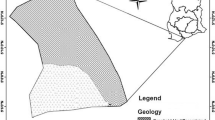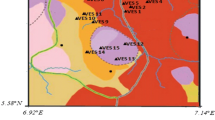Abstract
The groundwater development potential of the Ajumako–Enyan–Essiam (AEE) District has been assessed using vertical electrical sounding (VES) and borehole drilling data sets. The study aimed to use the available geophysical and hydrogeological data sets to assess the groundwater development potential of the District and also assess the aquifer protective capacity of the overburden rocks in protecting the groundwater from contamination. Twenty-nine VES points were probed up to a maximum electrode separation of 100 m using ABEM Terrameter SAS 1000 on selected sites. VES curves were interpreted quantitatively in terms of true resistivity and thickness manually by the conventional curve matching technique. The results were then improved by the computer using WINRESIST iteration software which gives the resistivity, thickness, and depth of the various layers. Thirteen out of the twenty-nine VES points were selected for drilling boreholes but three produced dry boreholes, while ten produced successful boreholes indicating a success rate of 77%. The ranges of borehole yield, static water level, transmissivity and specific capacity were 13–60 L/min, 7–18.98 m, 0.404–30.744 m2/d and 0.692–18.81 m3/day/m, respectively. There was a good correlation between the VES interpretation and borehole logs. The area was underlain by 3–5 geoelectric layers revealed by the different curves including HK (27.6%), H (20.7%), A (17.2%), K (6.9%), KH (6.9%), HA (6.9%), AK (6.9%), QH (3.4%) and HKH (3.4%). The groundwater development potential and aquifer protective capacity of the area were assessed by the calculation of reflection coefficients (r), longitudinal conductance (S), transverse resistance (Ti), transmissivity (T), and Specific capacity (Sp. Cap). The study showed irregular aquifer characteristics which leads to a heterogeneous hydrogeological environment. The study revealed high groundwater development potential but weak aquifer protective capacity of the study area. This makes the groundwater within the District prone to contamination as a result of the use of agrochemicals for farming, improper waste disposals and galamsey activities. Therefore, there is a need for protecting the groundwater resources from contamination by educating the people on the right ways of agrochemical application, proper waste disposal and use of pit latrine as well as the effects of galamsey activities on the groundwater quality. In addition, the people need to be educated on the need to assess the groundwater quality to ensure they meet the Ghana Standard Authority’s prescribed standard for drinking water before using it for drinking purposes.

Similar content being viewed by others
Data availability
All data used for this study are included within the manuscript.
References
Abdulaziz MA (2005) Resistivity methods for groundwater exploration in the cretaceous-tertiary sedimentary sequence, east of Jeddah, Saudi Arabia. J Environ Hydrol 13(19):1–11
Abiola O, Enikanselu PA, Oladapo MI (2009) Groundwater potential and aquifer protective capacity of overburden units in Ado-Ekiti, southwestern Nigeria. Intl J of Phys Sci 4(3):120–132
Ahmed S, Marsily GD, Talbot A (1988) Combined use of hydraulic and electrical properties of an aquifer in a geo-statistical estimation of transmissivity. Ground Water Hydrol 26(1):78–86
Ako BD, Osondu VC (1986) Electrical resistivity of the Kerri-Kerri formation, Darazo, Nigeria. J Afri Earth Sci 5(5):527–534
Ako BD, Ajayi TR, Arubayi JB, Enu EI (2005) The Groundwater and its occurrence in the coastal plains sands and alluvial deposits of parts of Lagos state. Nigeria Water Res 16:7–17
Amaya AG, Ortiz J, Durán A, Villazon M (2019) Hydrogeophysical methods and hydrogeological models: basis for groundwater sustainable management in Valle Alto (Bolivia). Sustain Water Resour Manag 5:1179–1188
Bhattacharya PK, Patra HP (1968) Direct current geoelectric sounding methods in geochemistry and geophysics. Elsevier, Amsterdam, p 135p
Bredehoeft JD (2002) The water budget myth revisited: why hydrogeologists’ model. Ground Water 40(4):340–345
Cooper HH, Jacob CE (1946) A generalized graphical method for evaluating formation constants andsummarizing well field history. American Geophysical Union, Washington
Dapaah-Siakwan S, Gyau-Boakye P (2000) Hydrogeological framework and borehole yields in Ghana. Hydrogeol J 8:400–416
Derie, Bereket M. (2019) “Integration of geophysical methods for groundwater exploration in hard rock areas: application to Alla Valley, Eritrea, NE Africa”. figshare. https://hdl.handle.net/2134/12616.
Dickson KB, Benneh G (1995) A new geography of Ghana, 3rd edn. Longman Group Ltd, Harlow
Ewusi A (2006) Groundwater exploration and management using Geophysics: Northern Region of Ghana. Thesis submitted as part of the requirement for the PhD Environmental and Resource Management degree, Faculty of Environmental Sciences and Process Engineering, BTU Cottbus, 3rd November 2006
Geological Survey Department G (2005) Geological Map of Ghana 1: 000 000. Geological Map of Ghana, Geological Survey Department, GSD
Geological Survey Department G (2009) Geological Map of Ghana 1: 000 000. Geological Map of Ghana. Geological Survey Department, GSD
Ghana Statistical Service (2013) 2010 Population and housing census: national analytical report.
Hassanein H, ELKaliouby H, ALGarni MA (2007) The use of DC resistivity to outline the subsurface hydrogeological and structural setting beneath a proposed site for subsurface DAM building, Makkah Al-Mukarramah, Saudi Arabia. J of King Abdul Aziz Univ Earth Sci 18(1):117–138
Henriet JP (1976) Direct application of Dar-Zarrouk parameters in ground water surveys. Geo Pros 24:344–353
Holland M. (2011) Hydrogeological characterization of crystalline basement aquifers within the Limpopo Province, South Africa. Submitted in the fulfilment of the requirements for the degree Doctor of Philosophy in the Faculty Natural and Agricultural Sciences. University of Pretoria, Pretoria, South Africa.
Junner NR (1935) Gold in the gold coast: gold coast geological survey. Memoir 4:67
Kalf FRP, Woolley DR (2005) Applicability and methodology of determining sustainable yield in groundwater systems. J Hydrogeol 13:295–312
Kelly WE (1977) Geoelectric sounding for estimating aquifer hydraulic conductivity. Ground Water 15(6):420–425
Kesse GO (1985) The mineral and rock resources of Ghana. A. A. Balkema, Rotterdam, pp 25–26
Kosinski WK, Kelly EW (1981) Geoelectric sounding for predicting aquifer properties. Ground Water 19:163–171
Krasny J (1993) Classification of transmissivity magnitude and variation. Groundwater 31(2):230–236
Lashkaripour GR, Sadeghi H, Qushaeei M (2005) Vertical electrical soundings for groundwater assessment in southeastern Iran: a case study. J of Appl Geophy 5(1):973–977
Leube A, Hirdes W, Mauer R, Kesse GO (1990) The early proterozoic Birimian supergroup of Ghana and some aspects of its associated gold mineralization. Precambrian Res 46(1–2):139–165
Loke, M.H., (1999).Time-lapse resistivity imaging inversion. In: Proceedings of the 5th Meeting of the Environmental and Engineering Geophysical Society European Section, Em1. Ghana Statistical Service, Accra, p 90
Maillet R (1947) The fundamental equations of electrical prospecting. Geophysics XII(4):529–556
Mazac O, Kelly WE, Landa I (1985) A hydrogeophysical model for relations between electrical and hydraulic properties of aquifers. J Hydrol 79:1–19
Niwas S, Lima OAL (2003) Aquifer parameter estimation from surface resistivity data. Ground Water 41(1):95–99. https://doi.org/10.1111/j.1745-6584.2003.tb02572.x
Niwas S, Singhal DC (1981a) Estimation of aquifer transmissivity from Dar-Zarrouk parameters in porous media. J Hydrol 50:393–399. https://doi.org/10.1016/0022-1694(81)90082-2
Niwas S, Singhal DC (1981b) Estimation of aquifer transmissivity from Dar-Zarrouk parameters in porous media. Hydrology 49:393–399
Olorunfemi MO, Ojo JS, Oladapo MI (1998) Geological Hydrogeological and Geophysical Investigations of Exposed 20″ Escravos Lagos Pipeline Technical Report
Olorunfemi MO, FasuyI SA (1993) Aquifertypes, geoelectric and hydrogeologic characteristics of part of the central basement terrain of Niger state Nigeria. J of Afri Earth Sci 16(1):309–317
Orellana E, Mooney HM (1966) Master tables and curves for vertical electrical sounding over layered structures intersciencia. Madrid 1966:150
Sanuade OA, Oyeyemi K, Amosun JO, Fatoba J (2018) Prediction of transmissivity of aquifer from geo-electric data using artificial neural network. IOP Conf Ser Earth Environ Sci 173:012025. https://doi.org/10.1088/1755-1315/173/1/012025
Sharma SP, Baranwal VC (2005) Delineation of groundwater-bearing fracture zones in a hard rock integrating very low frequency electromagnetic and resistivity data. J Appl Geophys 57:155–166
Sørensen KI, Auken E, Christensen NB, Pellerin L (2005) An integrated approach for hydrogeophysical investigations: new technologies and a case history. In: Butler DK (ed) Near-surface geophysics (vol 2). Society of Exploration Geophysics, Houston, pp 585–603
Soupios PM, Kouli M, Vallianatos F, Vafidis A, Stavroulakis G (2007) Estimation of aquifer hydraulic parameters from surficial geophysical methods: a case study of Keritis Basin in Chania (Crete-Greece). J Hydrol 338(1–2):122–131. https://doi.org/10.1016/j.jhydrol.2007.02.028
Telford WM, Geldart LP, Sheriff RE (1990) Applied Geophysics, 2nd edn. Cambridge University Press, Cambridge
Worthington PF (1976) Hydrogeophysical equivalence of water salinity, porosity and matrix conduction in erinaceous aquifers. Ground Water 14(4):221–232
Wright EP (1992) The hydrogeology of crystalline basement aquifers in Africa. Geol Soc Lond Spec Publ 66:1–27. https://doi.org/10.1144/GSL.SP.1992.066.01.01
Youssef MAS (2020) Geoelectrical analysis for evaluating the aquifer hydraulic characteristics in Ain El-Soukhna Area, West Gulf of Suez. Egypt NRIAG J Astron Geophys 9(1):85–98. https://doi.org/10.1080/20909977.2020.1713583
Acknowledgements
The author is grateful to the Management of the Community Water and Sanitation Agency, Cape Coast for making the data available for this study.
Funding
No funding was received by the author.
Author information
Authors and Affiliations
Corresponding author
Ethics declarations
Conflict of interest
The author declares that he has no conflict of interest.
Additional information
Publisher's Note
Springer Nature remains neutral with regard to jurisdictional claims in published maps and institutional affiliations.
Rights and permissions
Springer Nature or its licensor holds exclusive rights to this article under a publishing agreement with the author(s) or other rightsholder(s); author self-archiving of the accepted manuscript version of this article is solely governed by the terms of such publishing agreement and applicable law.
About this article
Cite this article
Agyemang, V.O. Assessment of groundwater development potential of aquifers within the Ajumako–Enyan–Essiam district of Ghana. Sustain. Water Resour. Manag. 8, 140 (2022). https://doi.org/10.1007/s40899-022-00728-8
Received:
Accepted:
Published:
DOI: https://doi.org/10.1007/s40899-022-00728-8




